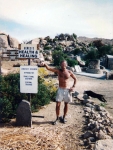A new project page for Juruseleme Village was added to this website: Earthbuildings in Fiji
Making Fijian Farmers Healthier and Wealthier
Bula and Happy New Year from Fiji. A rather timely article in the Huffington Post Online has just been posted that highlights some of the work that I am involved in here: http://www.huffingtonpost.com/claire-fordham/making-fijian-farmers-hea_b_8891832.html

The Organic Effect
Do you want to know what happens in your body when you switch from eating conventional food to organic? Watch this! The study was conducted by the Swedish Environmental Research Institute IVL, and the full report is available here: https://www.coop.se/organiceffect
Beyond Green & Earth Friendly “Why Burn”?
During the dry season, one cannot help but see all the burning going on. Many people have told me that they do not like to see the burning because of all the collateral damage to trees, structures and the obvious exposure of the bare earth to heavy rain and erosion (loss of top soil). This is fairly obvious to most people, including the ones doing the burning. How burning contributes to climate change is also something to consider.
I personally see burning as a loss of one of the most helpful building blocks for healthy food producing soil, “carbon”. When an area is burned, carbon is released into the atmosphere and ash is left. Ash is mostly lime, and lime changes the PH balance of the soil, which affects the plants ability to absorb nutrients. This affects the quantity of food that a field can produce (lower crop yield).
So what can a farmer or gardener do instead of burn? There is the time tested practice of pull and drop or cut and drop with grasses and weeds. In this practice, the pulled or cut material will break down naturally and the rain will slowly leach nutrients down to the root zone of whatever you plant. Using cows, horses, goats and sheep in intensive cell grazing (keeping the animal contained in an area) can accomplish much of the work of breaking down unwanted vegetation while adding value in the form of meat and milk and in the case of horses, draft (plowing) and transportation.
In areas that are thick with brush, vines and trees, there is another approach called Hugelkultur beds. This is where stumps, branches and brush are piled, covered with earth, and planted with trees, bushes ect. If you’ve ever seen a house built on a hillside where a pad (flat area) is made by pushing the earth and vegetation over the downhill side, the benefit of this practice can be observed. Trees and plants on the down hill edge of the pad will look noticeably bigger and healthier than others of their kind planted in plain top soil. The reason for this is the soil structure created here has available air for the microbes that feed the plant, slow released nutrients and minerals (including carbon) and some good drainage. When drought comes, the buried wood holds reserve moisture that the trees and plants can access.
There is another process called wood gasification, or pyrolysis, where a specially constructed oven (see video below) heats wood debris, but only burns the gas escaping to create charcoal or “Bio Char”. Bio Char is almost pure carbon, and can be crushed and added to soils to dramatically improve its productivity. This practice can significantly reduce the bulk of branches and sticks as well. The heat released in the process of making “Bio Char” can be utilized for drying or heating purposes, of which there are many. Your comments and suggestions are most welcome.
Anti-ageing and longevity research
Because of the technical and increasingly complicated direction of society as a whole, many simple and viable solutions to very basic real issues that we are confronted with in life have been left unexplored and undeveloped. Few, if any issues in life are more crucial than health and the quality and length of our lives.
The replication of the cells of our entire body is completed in seven years. During mitosis (the mechanism of cell replication) the cell is reproduced with a duplicate cell of a lesser quality. This loss of resolution is the human ageing process.
As explained in the “Hyporarithy” area of this website, the body is 80% water. Water expands when it gets hot and contracts when it gets cold. Assuming that the cell and the DNA within it are 80% water, they will expand and contract with hot and cold as well. They will be cleaner, healthier, and will function more efficiently, surrounded by cells, tissues and organs that are exposed to the same environment. Why? Because the elasticity that is promoted through mechanical movement (expansion and contraction) and exposure to fresh nutrients and oxygen make it so!
It is difficult to imagine that something as fundamental as this could have such a dramatic effect on something so critical and important to us without hitting the big screen. Can conscious heating and cooling of the body affect ageing? I fully believe so. Here is a photo of me, Richard, at age 51, when I was regularly engaged in “Hyporarithy”. Do you know, or have you seen anyone with skin and muscle tone of this caliber in this age bracket?












